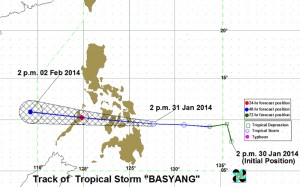 Storm signals were raised in 34 provinces on Friday as Storm Basyang gathered strength as it approached the country.
Storm signals were raised in 34 provinces on Friday as Storm Basyang gathered strength as it approached the country.
Among the areas in Basyang’s path are Leyte and Samar, which were devastated by Super Typhoon Yolanda in November.
At 1 p.m. on Friday, Basyang was tracked 376 kilometers east northeast of Hinatuan, Surigao del Sur, heading west with 55 kilometers per hour (kph) winds.
Moving at a relatively fast 30 kph, the storm is forecast to leave the Philippine Area of Responsibility (PAR) by Sunday morning.
Storm Signal no. 2 was raised in 13 provinces: Cebu, Bohol, Southern Leyte, Leyte, Eastern Samar, Samar, Camotes Island, Camiguin, Dinagat Province, Surigao del Norte including Siargao Islands, Northern Part of Surigao Del Sur, and the northern part of Agusan del Norte.
Signal no. 1 was up over 21 provinces: Masbate, Cuyo Island, Northern Samar, Biliran Island, Aklan, Capiz, Antique, Iloilo, Guimaras, Negros Occidental, Negros Oriental, Siquijor, Misamis Oriental, Misamis Occidental, rest of Agusan Del Norte, Rest of Surigao del Sur, Agusan del Sur, northern part of Bukidnon and Zamboanga del Norte.
The Philippine Atmospheric, Geophysical and Astronomical
Services Administration (Pagasa) alerted coastal residents in areas under Signal No. 2 to storm surges.
The storm surge whipped up by Yolanda was blamed for most of the deaths attributed to the super typhoon.
The government is considering the adoption a storm surge advisory (SSA) protocol and the flood advisory (FA) system, Presidential Communications Secretary Herminio Coloma Jr. said on Friday
“SSA number 1 indicates a storm surge height of up to two meters; SSA number 2, up to five meters; and SSA number 3, more than five meters. A storm surge advisory is given 48 hours in advance,” Coloma said.
“FA number 1, up to 129 mm rainfall within the next 24 hours; FA number 2, up to 190 mm rainfall; and FA number 3, up to 240 mm rainfall,” he added.
The storm surge advisory will be part of a disaster preparedness and risk reduction roadmap that President Benigno Aquino 3rd wants in place before the rainy season starts in June, Coloma said.
The President has formed a Cabinet-level task force to finalize a disaster plan for “highly vulnerable areas” in the country.
Making up the task force are Defense Secretary Voltaire Gazmin, Interior Secretary Manuel Roxas 2nd, Science and Technology Secretary Mario Montejo, Public Works Secretary Rogelio Singson, Environment Secretary Ramon Paje, National Climate Change Commission Secretary Mary Ann Lucille Sering and Trade Secretary Gregory Domingo.
“Priority areas of focus are highly vulnerable high-population areas such as the National Capital Region. How to restart the economy after a major disaster is another priority concern,” he said.
The President has also directed the Department of Interior and Local Government, Department of National Defense and Department of Social Welfare and Development “to complete post-disaster needs assessment reports for all 171 cities and municipalities affected by Yolanda to provide a reliable baseline for the implementation of recovery and rehabilitation efforts,” Coloma said
Aquino “also ordered the immediate completion of land-use plans that would clearly delineate no-build zones,” he added.
Citing a report from Rehabilitation czar Panfilo Lacson, Coloma noted the active support of development and sectoral sponsors from the country’s biggest corporations who have volunteered to spearhead rehabilitation efforts in 24 areas in the calamity zone.
He said that four pilot areas for rehabilitation have been targeted: Tacloban City, being the hardest-hit area, the economic center of Eastern Visayas, and the regional logistical hub; Tanauan, Leyte, for its tourism potential and build-back capacity; Guiuan, Eastern Samar, for the high level of private sector interest; and Biliran, for government-led programs.
WITH REPORT FROM CATHERINE S. VALENTE

